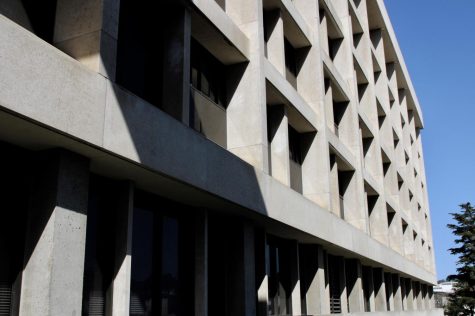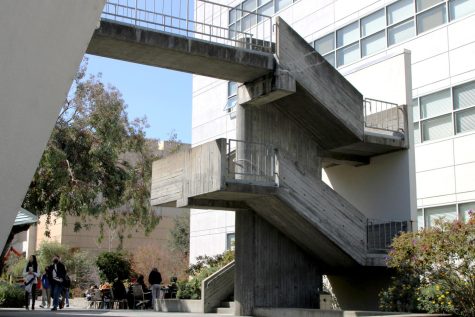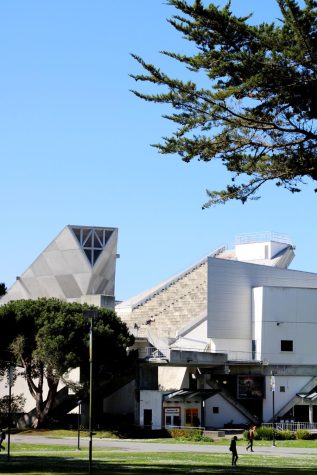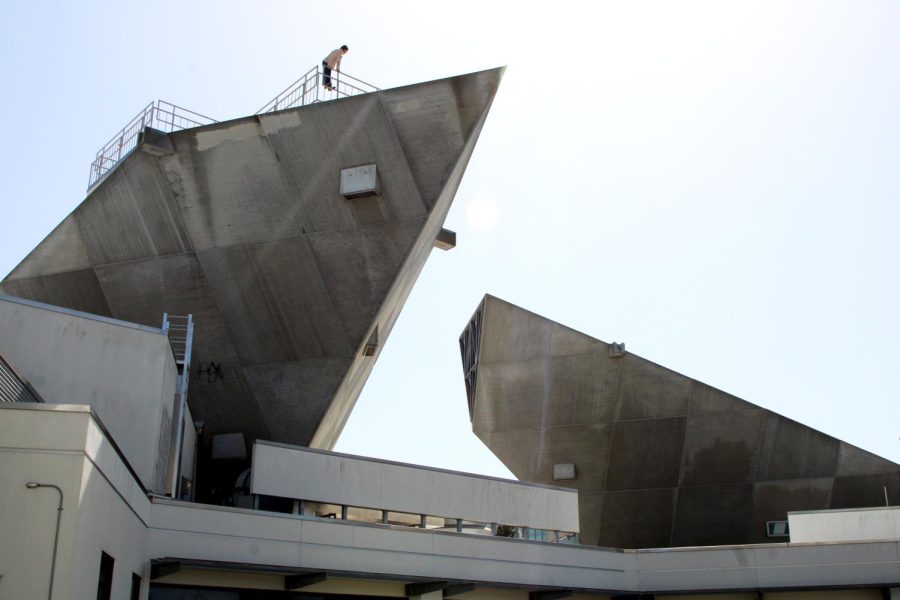Brutalist? Or Just Brutal to Look At?
A deep dive into SF State’s concrete jungle.
A person mounted on the edge of SF State’s Cesar Chavez Center Steps, on March 15, 2023. (Leilani Xicotencatl / Xpress Magazine)
What’s the first thing visitors to SF State notice? The grassy quad? The flashy library? The long line at Quickly?
The large number of concrete buildings?
SF State’s buildings don’t share much in common design-wise, except for the heavy presence of one building material: concrete. The Cesar Chavez Student Center, Thornton Hall and Student Health Services are dominant campus structures with concrete exteriors.

Concrete is often associated with Brutalism, the architectural style that emerged in the 1950s and early 1960s.
According to the Royal Institute of British Architects, Brutalist architecture “create[s] a sense of mass.” Brutalism rejects decorative features and remains minimalist. Geometric lines, odd shapes, contrasting textures — all of these are used to create a “memorable, powerful image.”
Brutalist design, wrote architect Simon Henley in Redefining Brutalism, started as “a design philosophy, not a style.” Darlene Tong, former architecture librarian at SF State echoed this via email: Brutalism involves “exposing the building’s inner workings rather than hiding building elements like utility lines, pipes, conduits, etc.”
Tong agreed that brutalist elements can be found in the student center. Tubes with giant vents for the below-ground floors sit in the dining hall. Massive concrete beams connect diagonally inside and out, and unpainted concrete staircases sit outside. Rather than hide the structure, architect Paffard Keatinge-Clay put it on full display.

Le Corbusier, a French Swiss architect Keatinge-Clay trained with, named the style “béton brut.” In French, the phrase translates to “raw concrete,” a practical description of the material’s condition. But Henley argues the term adapted a new meaning when translated. “Brutal,” in English, connotes harshness.
Brutalism, Tong explained, frequently used this “exposed, unpainted concrete.” A building isn’t inherently Brutalist because it’s made with concrete. But concrete is often employed in Brutalist design. Henley wrote, “the two are hard to separate in the collective psyche.”
The association may have ultimately dragged down Brutalism’s reputation. Because concrete can be cheap, it’s often used in cheap, ugly buildings that aren’t actually brutalist. Affordability, not architecture, may have drawn many government and campus buildings to feature concrete.
In particular, Brutalism gained a bad reputation at universities because of a popular theory that administrations used the architectural style — with its imposing shapes, odd entrances and complex floor plans — to deter riots after the student movements of the late ’60s. J. Bryan Lowder, writing for Slate, argues this is a myth. The dates don’t add up: Most brutalist buildings were built in the 1950s and early 1960s, when college administrations couldn’t have predicted the unrest to come. The more likely reason: Concrete was cheap.
But it might not be a myth for the SF State’s student center. The idea of a student union came about in the mid-’60s. In 1969, students approved a design by architect Moshe Safdie that also contained Brutalist elements. But the Board of Trustees rejected it for structural concerns. The rejection coincided with large-scale protests and strikes on SF State’s campus. Faculty even required the board to approve Safdie’s design in their strike demands to show solidarity with students. Safdie was ultimately removed from the project; Keating-Clay replaced him. Construction started in 1973, and the student center opened two years later.
Tong said that, though it may be just rumor, she heard that Keating-Clay’s design was chosen “because there were not large open spaces in it for ‘student protest congregations.’” So it is possible the protests had an effect on the design.

Whether or not the buildings were actually Brutalist or intended to limit dissent, the fact that governments and universities frequently used concrete — with what some consider a cold architectural style — drew an association in the public’s mind between Brutalism and totalitarianism.
This association is ironic, as brutalism pushed against repression and order, defying the status quo in its refusal to hide structural elements. As Henley wrote, brutalism “stripped back rendered surfaces and allusive images to reveal the concrete physicality of things.”
SF State’s buildings have brutalism’s trademark building material and cold vibe. But, aside from the student center, are any buildings on campus brutalist?
According to Tong, no.
“There are a lot of ugly buildings on the SF State campus,” Tong wrote, “but [they] don’t seem to me to fit the bill of ‘brutalist’ architecture.”
John Fung, principal architect for Mark Cavagnero Associates — the team behind the recently-built Marcus Hall — was kinder. He called SF State’s buildings “eclectic,” but said they lack a unifying design element found on more traditional campuses.
So why use so much concrete in Marcus Hall, if Fung says it contains no brutalist elements?
“It’s structural; it’s acoustics,” Fung said. “And it’s, in some ways, a very honest material.”

Sarah Bowen is a journalism major and philosophy minor originally from Los Angeles. She transferred to SF State from the University of Oregon in 2021....

Leilani Xicotencatl (she/her) is the Photo Editor for Xpress Magazine and a photographer for Golden Gate Xpress. She was born and raised in Anaheim, California....


